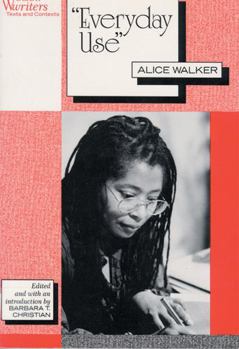Everyday Use: Alice Walker
Select Format
Select Condition 
Book Overview
Alice Walker's early story, "Everyday Use," has remained a cornerstone of her work. Her use of quilting as a metaphor for the creative legacy that African Americans inherited from their maternal ancestors changed the way we define art, women's culture, and African American lives. By putting African American women's voices at the center of the narrative for the first time, "Everyday Use" anticipated the focus of an entire generation of black women...
Format:Paperback
Language:English
ISBN:0813520762
ISBN13:9780813520766
Release Date:June 1994
Publisher:Rutgers University Press
Length:240 Pages
Weight:0.93 lbs.
Dimensions:0.7" x 6.0" x 8.9"
Customer Reviews
4 ratings
Walker's best short story
Published by Thriftbooks.com User , 15 years ago
Everyday Use (Women Writers) Walker's iconic short story about our changing times. I use this in several of the courses I teach. Each class ends up arguing over who is right.
Black Identity Crisis and Conflict in "Everyday Use"
Published by Thriftbooks.com User , 17 years ago
This is a story, set in the rural American south, family house in a pasture, in which an African-American mother, "Mama Johnson," who grew up in the early part of the past century, struggles to absorb, understand, evaluate and appreciate the ramifications of her strongly bucolic and dirty background in comparison with a daughter (Dee) who had obtained an impressive advanced formal education in Augusta in Georgia and migrated to work in an urban environment. Mama, in several ways, views her other daughter, Maggie, who is in the comparison, as the less fortunate one. Her ungenerous appearance partly stems from a house fire that left her with severe burns from which conspicuous scars remain. In Mama's words: "Have you ever seen a lame animal, perhaps a dog run over by some careless person rich enough to own a car, sidle up to someone who is ignorant enough to be kind to him? That is the way my Maggie walks. She has been like this, chin on chest, eyes on ground, feet in shuffle, ever since the fire that burned the other house to the ground. Dee is lighter-skinned than Maggie, has nicer hair and a fuller figure." The story begins with Mama and Maggie awaiting the visit of Dee. Despite Dee's being a direct blood relative, the two went to great lengths, the previous afternoon to make the yard, "so clean and wavy." This is a moving short story that illustrates the conflicts between formal education, rural tradition, urban modernism, culture, individualism, egocentricism, community, cooperation, family relationships, esthetic appearances, capitalism, morality, abandonment, transformation, opportunism, intimidation, oppression, and emancipation. The story illustrates a common American scene, more so in the African-American context. It was realized, early, in life that Dee was the significantly brilliant and ambitious one of the two daughters, she longed for the modern advanced setting; in Mama's words, "She use to read to us without pity; forcing words, lies, other folks' habits, whole lives upon us, sitting trapped and ignorant underneath her voice. She washed us in a river of make-believe, burned us with a lot of knowledge we didn't necessarily need to know." She was outspoken and unabashed, loved to dress well and display her beauty, "Dee wanted nice things." Mama, a woman whose formal school education was shut down in 1927 right after she had achieved a second grade education, apparently embraces her daughter's brilliance and ambitiousness by raising money, with the help of their church to send her to school in Augusta. Mama and Maggie, must have, on one hand, been eager to see Dee leave the home habitation, at least for sometime. The aura in the story, of her boldness, ambitiousness, and zeal for sophistication and achievement making people uneasy while struck with awe, is very powerful. Dee was a young lady of beauty and sophisticated language; Mama tells Maggie that she knows of some childhood friends that Dee had. To Mama, such friends were mostly
Everyday Use puts a spoiled child in her place..
Published by Thriftbooks.com User , 20 years ago
I think this book's imagery is amazing, and really gives you the perfect picture of the characters. Alice Walker did a great job "weaving" this story and showing us different kinds of African Americans and the heritage that is passed down with family traditions and quilts. This is definitely worth a read to all people, African American or not because we all can relate to the emotions the characters feel. This story is about a mother who was always torn between her two daughters and finally learns how to take a stand. Read it and enjoy!
Everyday Use
Published by Thriftbooks.com User , 24 years ago
I think this book is very good to learn a lesson about hertiage. Of how you should use your hertiage in everyday use and not just hang and display it to others.






